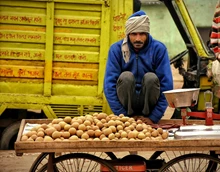
Ravi works at a factory set up in the outskirts of his village which is 15 km away from his home. Earlier he waited for the public transport to help him reach at his work place, which too is not regular in its service. Things got better for him when he applied for a loan to get his new 110 cc bike. Now he drops his daughter at the school before going for work. This new assistance of his, also helps him in carrying the fooder for his 2 dairy animals. This 2 wheeler made his life easier. There are numerous Ravi(s) in the country who are relying upon the automobiles for making their life easier.
In rural India, An automobile is not limited to bring two spots closer but becomes a partner in one's economic emancipation. Agriculture being a seasonal occupation, farmers can rely on other segments to work if they have a mode to make things easier for them. Other than agricultural equipment and machinery there are other factors too which affect this sector. Transportation and ease of movement is one of them.

Rs 1.21 lakh crore (US$ 18.69 billion) is the Union Budget 2018-19 for the road sector. Rs 71,000 crore (US$ 10.97 billion) have been allocated specifically for the development for the national highways in the country. With this huge investment in the infrastructure, it is pushing other sectors to develop, one of such sector is the automobile, which literally runs on this infra.
Where on one hand, the entry segment bikes under 150/180 cc has reached a threshold in urban areas, they are catching pace in terms of sale in rural and semi-rural areas. States like, Uttar Pradesh, Bihar, West Bengal, Rajasthan, Chattisgarh etc. who are yet to see huge numbers in the economic output have significant potential for such bikes. Brands like Hero and Bajaj still rule the rural areas. Hondo is doing better with its scooter segment, which is highly popular equally in rural and urban areas.
Government permitting 100 per cent foreign direct investment (FDI) in the road sector, several foreign companies have formed partnerships with Indian players to capitalize on the sector's growth. In April 2018, the Government of India signed a US$ 210 million deal with World Bank to improve rural roads at a stretch of 10,510 km in Madhya Pradesh under the Gram Sadak Yojana programme. Better road conditions also push the sale of automobiles in an area, since better connectivity gives better options to connect with the urban areas which are the highest profit making market for the rural products, which eventually increases the purchasing power of the rural population. The Ministry of Road Transport and Highways, has fixed a target of 20,000 kms for 2018-19 which is 25 per cent more than 17,055 kms awarded in 2017-18.

Though the contribution of deluxe and premium bikes is still less in northern, central and eastern rural areas. West and south witnesses a good ratio of such bikes due to higher literacy levels in the areas. Yamaha is one such name, which is doing comparatively better with its higher cc and heavy duty cycle motorcycles.
With the increasing number of women riders, The scooter segment has found a new market in the rural India. All the 2-wheeler companies are focusing deeply on this sector. Since, Scooter provide easy ride and hence is an attractive option for the rural families. TVS Jupiter has got itself much appreciation. Honda with its Aviator and Activa, Hero with its Pleasure, Maestro and Duet is competing in this segment.










